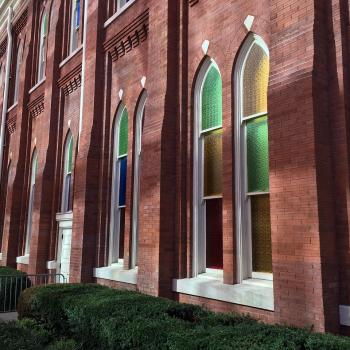By Miles Hartog - May 25, 2009
Shavuot is both an agricultural festival as well the commemoration of the time the Jewish people received the Torah (the word of God) at Mount Sinai, following the Exodus from Egypt.
 It has been said that while other peoples and religions build their monuments in space (cathedrals, coliseums, giant rings of stone), Judaism builds its monuments in time.
It has been said that while other peoples and religions build their monuments in space (cathedrals, coliseums, giant rings of stone), Judaism builds its monuments in time.
The basic building blocks of those monuments are the festivals; each monument covers the cycle of the Jewish year, and the full plethora of monuments is the weave of Jewish history.
Throughout history - whether in their own kingdom in ancient Israel or through the two thousand years of Diaspora under the rule of others - Jews have centered their lives around this cycle.
The most fundamental units of this cycle are the three festivals of pilgrimage to Jerusalem. During the time of the Temples in Jerusalem, whether the first temple built by King Solomon, or the second built later and known at the height of its status as the Temple of Herod in Roman times, all Jews would make the ascent to worship G-d three times a year - on Passover (Pesach), the Feast of Weeks (Shavuot), and Tabernacles (Succot).
Each festival has multiple layers of meaning, working on the level of agricultural holidays connecting the people to the land, spiritual holidays connecting the people to their G-d, and historical holidays, connecting the people to their past as a nation.
The festival that we shall celebrate starting this Thursday evening is the Feast of Weeks - or "Shavuot" in Hebrew. It is a festival that lasts one day in Israel, two in the Diaspora. This is the second of the three festivals of pilgrimage, and always arrives on the 50th day after Passover ("Pesach").
On the agricultural level, Shavuot is a feast of thanksgiving, marking the end of the period of grain harvest, at which time the Jews would bring two loaves of bread baked from the grain of the land as praise and thanks to the Almighty. It also marks the beginning of the fruit harvest season, and so each Israelite would bring to the Temple a basket filled with the first fruit that ripened on his land as a thanksgiving offering.
On the spiritual and historical level, Shavuot is the commemoration of the beginning of the Israelites' spiritual life as a people, as it is the time at which they received the word of G-d in the form of the Torah (the "Law" or the "Teaching"), at Mount Sinai. Moses, who led them out of Egypt in the great Exodus, brought them to the mountain where G-d brought the divine word for the first time down to the earthly realm, and gave it to the Jewish people. The Torah forms the base of the Old Testament of Christianity and a significant part of the source material of the Quran. The Jewish people, after being born as a nation when leaving Egypt at Passover, are now reborn as a spiritual people who accept the yoke of the L-rd's commandments upon them unconditionally, replacing the Pharaoh's harsh enforced slavery with a subjugation by choice to G-d's will.
As opposed to the other two pilgrim festivals of Passover and Succot, the date of Shavuot is not set in stone, but rather it is connected to Passover, always following it by exactly seven weeks. For this reason it is called the festival of weeks - the Jews having spent the intervening days (called the "Omer") counting the days and weeks as they pass, in anticipation of the holiday, and the annual reaffirmation of the original receipt of the Torah.
On Shavuot we have the tradition of staying awake all night and learning from the Torah and other Jewish texts, in commemoration of the original giving of the Law, and also as an act of showing our love of the Torah and desire to receive it with excitement, the anticipation and experience of the receiving keeping us awake all night.
On this festival we eat foods made from milk products for many symbolic reasons, one being that the Torah is likened to "Milk and Honey."
We read in the synagogue the book of Ruth, the story of how this Moabite woman who married a Jew in the time of the Kingdom of Israel embraced Judaism and forsook her roots for the heritage of her mother-in-law. The story resonates with human messages of acceptance of the other, communal support of the poor, and the reward for loyalty, virtue, and righteousness. It depicts a society filled with social justice, and reminds us that the laws of the Torah are not merely ceremonies or arcane practices, but the living heart of a society of people dedicated to caring for each other.
Ruth was the forebear of King David, showing us that from these values can arise a great kingdom, the archetypical ruler who combines compassion and social conscience with trust and belief in G-d and adherence to his laws.
Chag Sameach - Happy Holiday to all.
Miles Hartog is an Australian-born architect, living in Israel since 1993. He lives in Gush Etzion, just south of Jerusalem with his wife and five boys (soon to be joined by twins).
1/1/2000 5:00:00 AM




